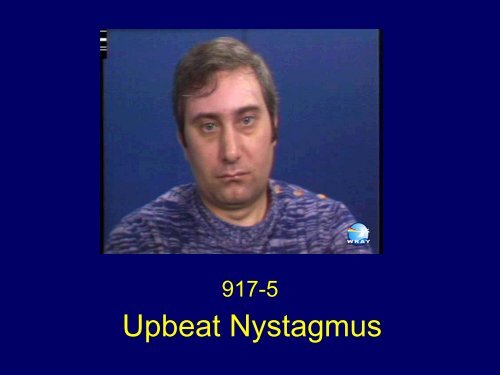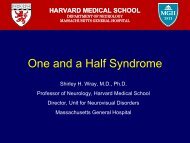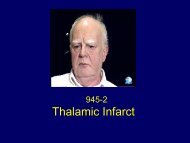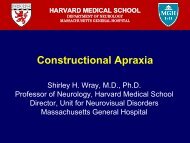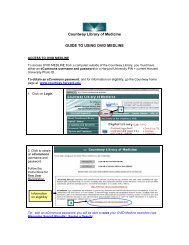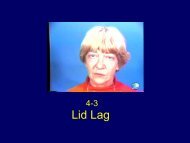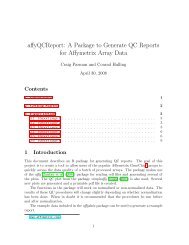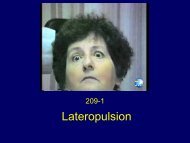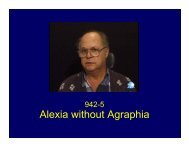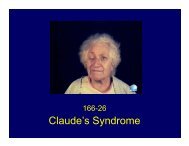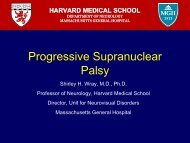You also want an ePaper? Increase the reach of your titles
YUMPU automatically turns print PDFs into web optimized ePapers that Google loves.
917-5<br />
<strong>Upbeat</strong> <strong>Nystagmus</strong>
Eye Movements<br />
<strong>Upbeat</strong> nystagmus in primary gaze<br />
Horizontal gaze evoked nystagmus left ><br />
right<br />
No nystagmus on downgaze<br />
Saccadic pursuit in all directions.<br />
Square wave jerks
Dysmetria<br />
Marked saccadic hypermetria<br />
Right gaze to center overshoot<br />
(hypermetria) taking the eyes almost<br />
fully to the left<br />
Left gaze to center (hypermetria) taking<br />
the eyes almost fully to the right<br />
Upgaze to center hypermetria<br />
Downgaze to center hypermetria
Clinical Features of <strong>Upbeat</strong><br />
<strong>Nystagmus</strong><br />
Present in primary gaze usually increases<br />
on upgaze<br />
Slow phases may have linear-, increasing-,<br />
or decreasing-velocity waveforms<br />
Poorly suppressed by visual fixation of a<br />
distant target
Clinical Features of <strong>Upbeat</strong><br />
<strong>Nystagmus</strong><br />
Convergence may increase, suppress or<br />
convert to downbeat nystagmus<br />
Associated with abnormal vertical<br />
vestibular and smooth-pursuit responses,<br />
and saccadic intrusions (square-wave<br />
jerks) that produce a bow-tie nystagmus
<strong>Upbeat</strong> <strong>Nystagmus</strong><br />
Localizes to the Caudal Medulla with the<br />
lesion affecting the perihypoglossal group<br />
of nuclei including:<br />
nucleus intercalatus<br />
nucleus of Roller<br />
nucleus of pararaphales
<strong>Upbeat</strong> <strong>Nystagmus</strong><br />
More rostral brainstem lesions may<br />
interrupt the ventral tegmental tract<br />
containing projections from the vestibular<br />
nuclei that receive inputs from the anterior<br />
semicircular canal<br />
Involve the brachuim conjunctivum in the<br />
rostral pons and medulla.<br />
or
Etiology of <strong>Upbeat</strong> <strong>Nystagmus</strong><br />
Infarction of medulla or cerebellum and<br />
superior cerebellar peduncle<br />
Wernicke’s encephalopathy<br />
Multiple sclerosis<br />
Tumors of the medulla, cerebellum or<br />
midbrain<br />
Cerebellar degeneration or anomalies
Etiology of <strong>Upbeat</strong> <strong>Nystagmus</strong><br />
Brainstem encephalitis<br />
Creutzfeldt-Jacob disease<br />
Bechet’s syndrome<br />
Meningitis<br />
Thalamic arteriovenous malformation<br />
Transient finding in infants
Clinical Features of Torsional<br />
<strong>Nystagmus</strong><br />
Torsional jerk nystagmus (minimal vertical<br />
or horizontal components) present with<br />
eye close to central position.<br />
Slow phases may have linear-, increasing-<br />
, or decreasing-velocity waveforms<br />
Poorly suppressed by visual fixation of a<br />
distant target<br />
Exacerbated by changes in head position<br />
or vigorous head shaking<br />
Leigh JR and Zee DS. The Neurology of Eye Movements 4 th Edition.<br />
Oxford University Press, New York 2006 with permission
Clinical Features of Torsional<br />
<strong>Nystagmus</strong><br />
May be suppressed by convergence<br />
Often occurs in association with ocular tilt<br />
reaction or unilateral internuclear<br />
ophthalmoplegia<br />
May be precipitated or modulated by<br />
vertical smooth pursuit movements.<br />
Leigh JR and Zee DS. The Neurology of Eye Movements 4 th Edition.<br />
Oxford University Press, New York 2006 with permission
Etiology of Torsional <strong>Nystagmus</strong><br />
Syringobulbia, with or without<br />
syringomyelia<br />
Arnold-Chiari malformation<br />
Brainstem stroke (e.g., Wallenberg’s<br />
syndrome)<br />
Arteriovenous malformation in the<br />
brainstem or middle cerebellar peduncle<br />
*Often occurs in association with the ocular tilt reaction and unilateral<br />
internuclear ophthalmoplegia.<br />
Leigh JR and Zee DS. The Neurology of Eye Movements 4 th Edition.<br />
Oxford University Press, New York 2006 with permission
Etiology of Torsional <strong>Nystagmus</strong><br />
Brainstem tumor<br />
Multiple sclerosis<br />
Oculopalatal tremor (“myoclonus”)<br />
Head trauma<br />
Congenital
References<br />
The Neurology of Eye Movements, 4 th Edition,<br />
Oxford University Press, New York, 2006.<br />
Tilikete C. Koene A. Nighoghossian N, Vighetto<br />
A, Pelisson. Saccadic lateropulsion in<br />
Wallenberg syndrome: a window to access<br />
cerebellar control of saccades? Exp Brain Res<br />
2006;174(3):555-565.
Tilikete C, Hermier M, Pelisson D, Vighetto<br />
A. Saccadic lateropulsion and upbeat<br />
nystagmus: disorders of caudal medulla.<br />
Ann Neurol. 2002 Nov;52(5):658-62.
http://library.med.utah.edu/NOVEL


